
As Close as You Can Get To Red Dead In Real Life
So recently, like many, I’ve been pretty sucked into playing Red Dead Redemption 2. Yes, sometimes I like to sit around, be lazy and enjoy video games. So anyway, as I was playing, it got me to thinking about many of the ghost towns I have photographed out west. I thought to myself ‘hey, I’ve actually seen a lot of stuff like this in real life!’ Probably why I loved finding these ghost towns so much – thanks to the first Red Dead Redemption. I enjoy taking inspiration from video games. Hey, it’s what got me into photographing abandoned places in the first place! (insert 10,000 references to Silent Hill and Resident Evil)



 So, I’ve decided to put a list together of places that I have visited; all of which are open and viewable to the public! This makes it even better for those who are out to fuel your need to wander through a real-life wild west town. I know that’s how I’m feeling after playing Red Dead for the last few days. Because aside from loving the virtually created worlds in video games, I love to find them in real life.
So, I’ve decided to put a list together of places that I have visited; all of which are open and viewable to the public! This makes it even better for those who are out to fuel your need to wander through a real-life wild west town. I know that’s how I’m feeling after playing Red Dead for the last few days. Because aside from loving the virtually created worlds in video games, I love to find them in real life.


So below, find a selection of wild west ghost towns you can actually visit!
Jump To A Section:
ToggleOatman, Arizona – Population 128
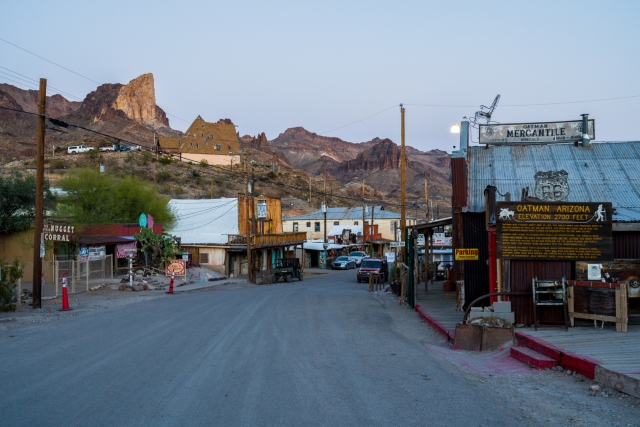
Oatman, Arizona – a town where the donkeys outnumber the people. Now, that started out as a joke, but I honestly believe that this could very well be the case for this old western town. With a population of only 128, it’s fun to imagine what life is like here out in the Arizona desert when the sun goes down and tourists go home.
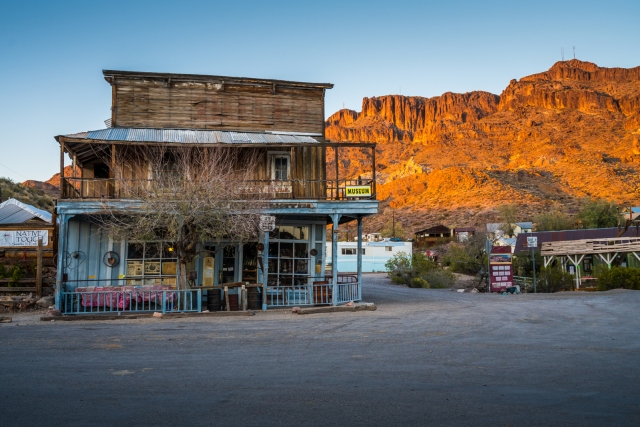
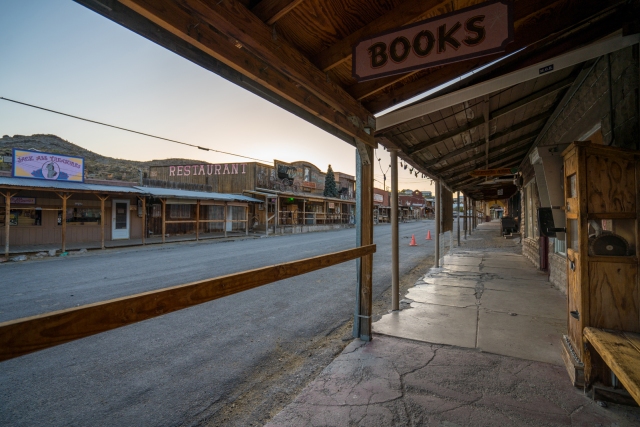
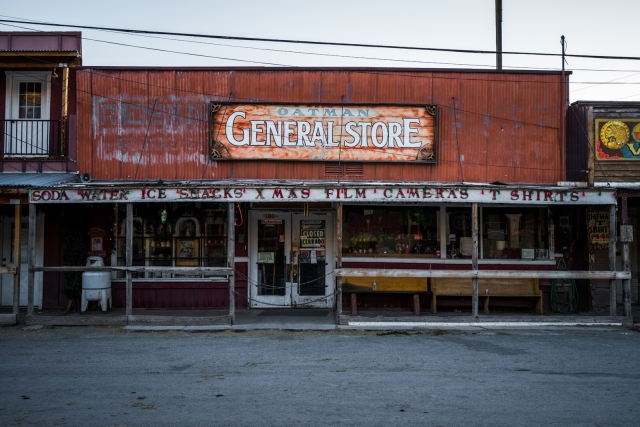
The name “Oatman” was chosen in honor of Olive Oatman – a young Illinois girl taken captive by Indians during her pioneer family’s journey westward in 1851. She was forced into slavery, and later traded to Mohave Indians. They brought her in, adopting her as their own, and even tattooing her face in custom of the tribe. She was released in 1856 at Fort Yuma, Arizona.
Though Oatman was established in the 1800s, it was not until the early 20th century that it boomed. For a decade, most of the gold produced came from Oatman after a very rich ore body was discovered in 1915. Oatman was among the largest gold producers in the American West.

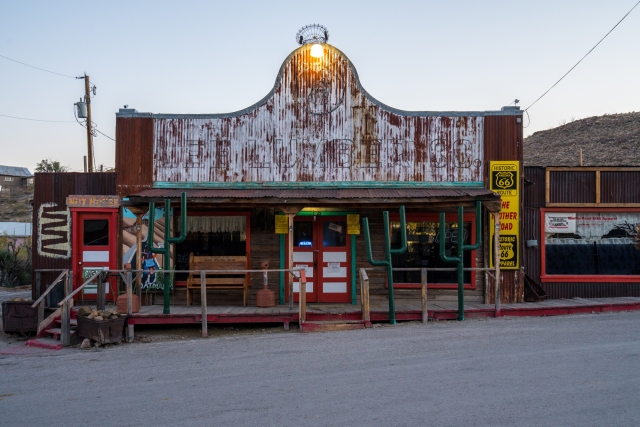
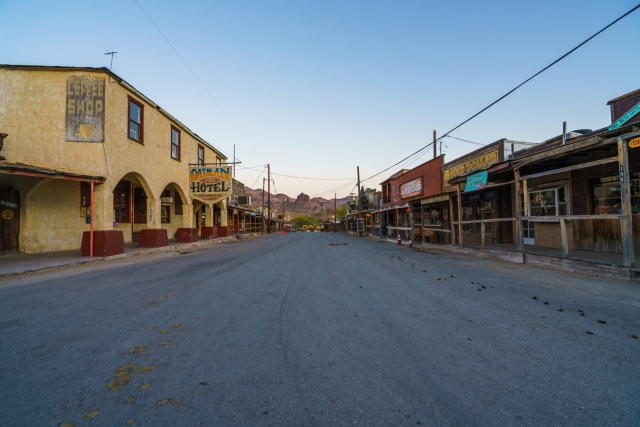
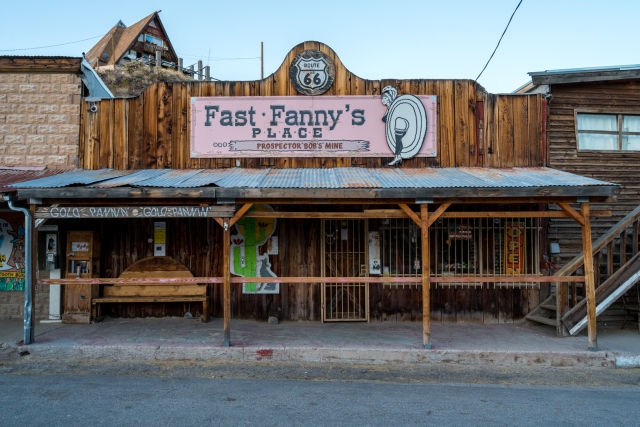
In 1921, a fire swept through Oatman, burning many of the town’s smaller buildings, but did not harm the Oatman Hotel. The hotel was built in 1902, and is the oldest two-story adobe structure in Mohave County. The hotel is well-known as the famous honeymoon stop of Clark Gable and Carole Lombard after their wedding in Kingman on March 18, 1939.
Shaniko, Oregon – Population 37
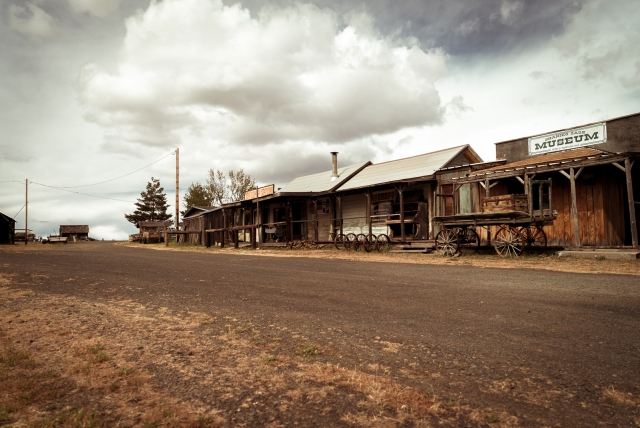
As I crossed over a small hillside, my destination became clear – the once bustling town of Shaniko, Oregon. Stepping from my car, I drew in a breath. A breeze of wind slowly swept past, and I could smell the comforting scent of fresh spring rain from miles away as it fell peacefully to Earth. In the far distance, I watched collected raindrops pouring from the sky like a ghostly curtain hanging from the clouds. Cold rain met a warmer ground and was absorbed into the freeway’s smooth pavement, which stretched for miles across Oregon’s open countryside hills. As surrounding soil drank the rain water, a dark and clouded blue sky hovered overhead, leaving just enough open space between clouds to let an evening sun pass through, painting the town a strongly contrasting bright gold.


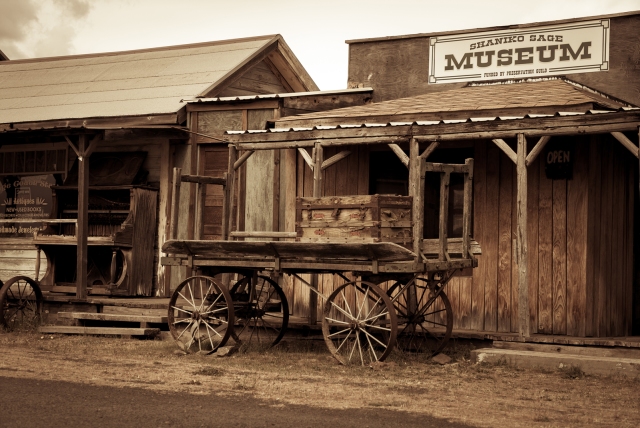

I was taken away the moment I set foot on this town’s main street – absorbing the beautiful and serene setting surrounding me. I became intrigued further by each building or object I would pass, submersed in the brilliant calm that this town seemed to give off. I wandered up and down each intersection, until a large open door caught my attention; an entire garage filled with old, dusty cars. The garage now silently sits as a museum for those interested enough to learn about the history that would have passed through Shaniko. Vehicles from old Chryslers to a 1919 Studebaker – even Chevrolets from as far back as 1918 all sit now collecting dust. One can only imagine the incredible stories these cars would have to tell.
So how did Shaniko – one of the most famous ghost towns in Oregon, come to existence in the first place?
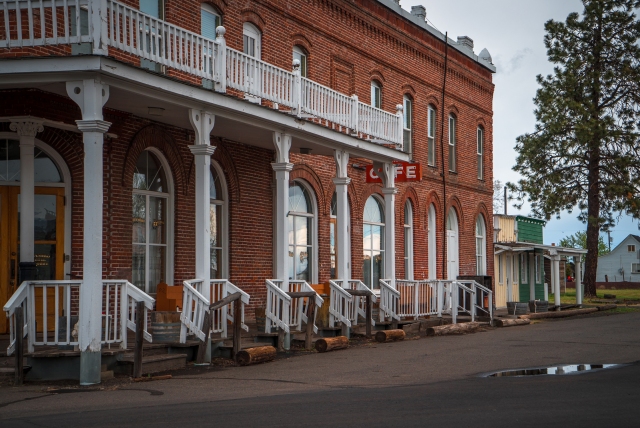
The year was 1862, and the Homestead Act had just been put into place as people began to settle. By the year 1898, with no efficient way for goods to be transported came the proposal for a railroad to be built. The construction of this railway sparked the idea of a town, and by 1900 the tracks of the Columbia Southern Railroad Line finally made it to the future home of Shaniko, Oregon. By 1901, Shaniko was established and commerce had already begun, with this railway making Shaniko a hub for all of Oregon’s interior trade straight down to the California border. During the year of 1903, Shaniko had become famous for its wool trade, being the town’s claim to fame. World records were set for wool production, with some days yielding up to $3,000,000 in transactions for a single day. However, it was not long after this that the town would begin a sharp decline.
By 1910, population was at its peak with 495 residents, but never broke 500 before the town began quickly falling apart. With only 10 years heavily involved in trade came a very sudden, very early recession for Shaniko. In the year of 1911 alone, not only was the mayor assassinated, but so came the end of the Columbia Southern Railroad Line, halting wool production, as well as any other major trade. With its heyday turning to grey days, population quickly dropped, and by 1920 sat at only 124 people – down 74.9 percent from the 1910 census.

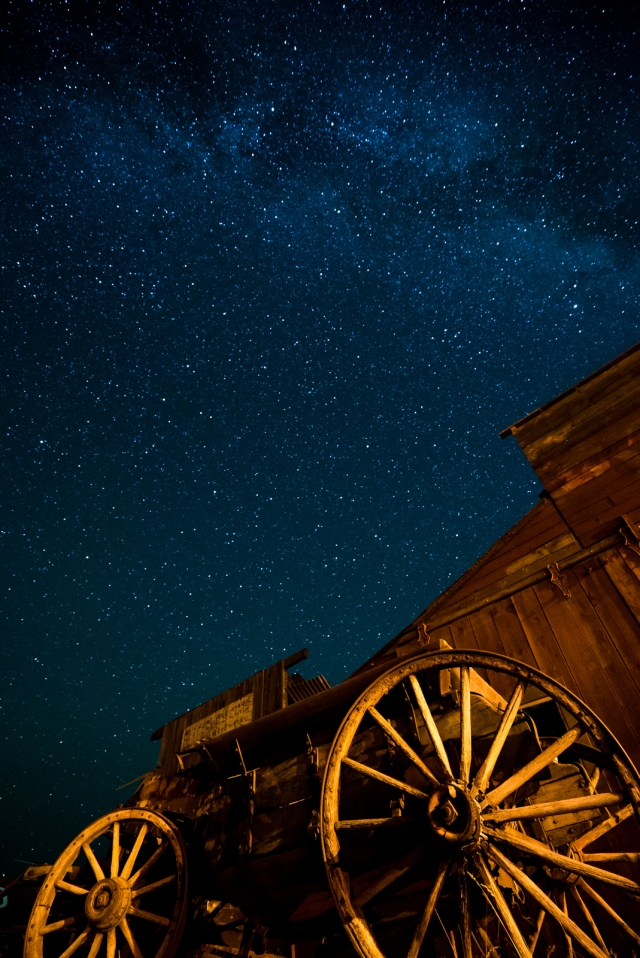
Between 1920 and 1970, numerous other incidents continued to negatively impact Shaniko, including several major fires, taking most of the town’s business district and turning it to smoldering ash. With population rapidly declining following these fires, the school shuttered its doors in 1951 – but it wouldn’t be long before a growing interest would arise in the study of ghost towns, and Shaniko would begin to garner attention from many interested travelers. Through the 1960s, this growing interest would bring a small revival to the town of Shaniko from all those passing through, though not large enough to sustain a full recovery to the bright life it once lived. During the late 70s through early 80s, preservation became paramount and a much greater effort was put into effect, attempting to save the town for eyes and ears of future generations to see and learn.
“Shaniko calls the people she needs to survive,” I was told by one current resident, Debra Holbrook, who moved to the town in 1993. Debra had a goal of bringing Oregon history to people, sharing with adults and children, taking them to places where history happened. Just like me, she was never incredibly interested in history during her school years. Moving to Shaniko opened her eyes to a brand new world of discovery, and the idea to preserve the stories of places such as this one became a quickly growing interest.

“The only word that could describe it was home,” Debra told me as we talked. By 1996, Debra was still living in Shaniko, running a shop with her mother and enjoying the peacefulness of this countryside town just as much as ever. As years passed, more shops and buildings were eventually closed including the large hotel, which now sits an empty shell looming over the center of town. Days dragged by, population fluctuated, and numerous people continued passing through just to hear a nearly forgotten history and learn the tale of this once vibrant town. To this day, Shaniko still welcomes visitors with open arms, provided they have open minds and genuine interest.
With a current population of only 36, it’s no surprise that I was able to meet some amazing and very friendly people – people who were more than excited to share stories of the town’s past, and were incredibly inviting as well as helpful. The remaining life in this town made it easily one of the most unique and peaceful places I have had the pleasure of visiting in my travels. As quantity of people decreases, qualities greatly increase – it seems to happen that way more often than not in towns like this. I think what made this adventure seem even stranger to me than normal is the fact that I have photographed many places, but none that were built up so greatly only to fall so quickly.

While sometimes it seems like the life of these forgotten places fades faster than interior lights of a locked car – other places, such as Shaniko keep at least a small glow, refusing to go out. I will always say I believe that it’s important for us to save these memories in hopes of making them last forever. I’m here now, and plan to save as many stories as possible while I have the chance.
Cuervo, New Mexico – Population like…1 or 2?
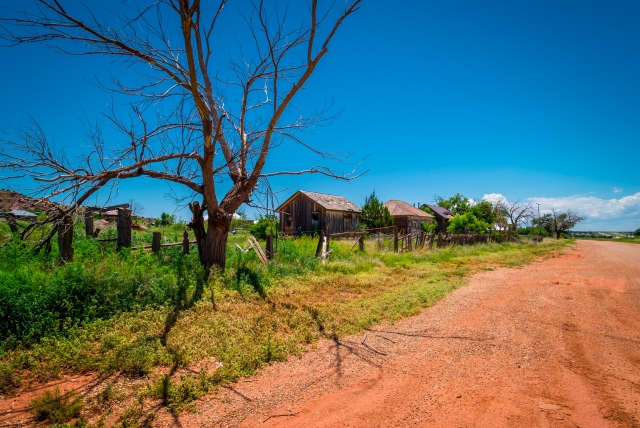
The sun had sunk – a red glow melting away into the horizon, bringing an end to another fading evening; another passing day. I had just left Utah, and soon found myself crossing the Colorado state line into New Mexico. Vast plains and dark desert greeted me, while an ominous night sky began to drop rain from overhead. A very unsettling welcome sign almost fully covered, mostly in obscure, anarchic graffiti made me feel as though I was entering the exit of humanity. It’s something that you just don’t see often while traveling the country, as most welcome signs are normally clear and free of any trace of vandalism. Being so many miles from much civilization, these particular signs must receive very minimal attention. It seemed like every sign I continued to pass was increasingly difficult to decipher through the layers of careless graffiti scrawled upon federal aluminum freeway canvas. What no travel brochure will tell you about entering some parts of New Mexico is that the freeway will provide you, and your car with the most uncomfortable full-body massage of your life. I proceeded to drive these pothole-infested roads straight into a seemingly ungoverned and reckless place – but oddly enough, the scenery left me feeling relaxed. Driving these roads, however continued to knock my relaxed state every other few seconds; it was like rolling a Hot Wheels car over the backs of 500 Suriname toads that had just given birth. The potholes were larger than Joe M’s ego, and emptier than his head. Nearing Albuquerque, I figured it was time to get some rest. It was now 4 o’clock in the morning, and I somehow managed to hold my eyes open for another hour while I searched Route 66 for a good place to lay low, and wait for sunrise…in three hours. I situated myself beneath a large neon Route 66 sign and prepared to sleep. Bright light fell from the massive logo above, touching the street below and painting the surrounding area with a deep, neon blue glow. I quickly drifted off, with the sky already fading into an aqua hue, welcoming daylight.

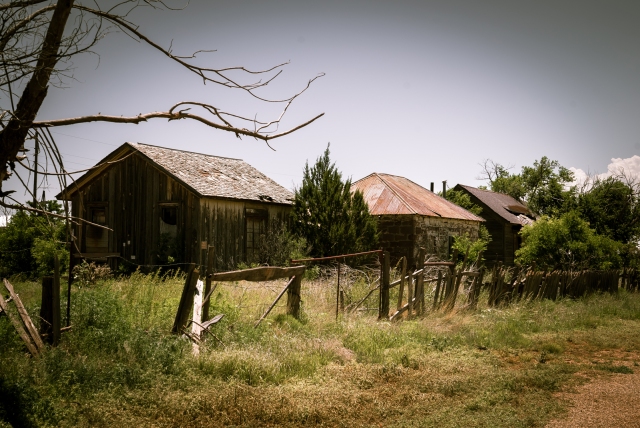
Waking only a few short hours later from an incredibly quick rest – if you even want to call it that – I was back on the road in search of the perfect subject; something that I could be proud of adding to my portfolio. Not long into my drive, I stumbled upon exactly what I was looking for when I found myself staring directly into a beautiful broken down ghost town. Just one road over from the infamous Route 66 in New Mexico sits the eerie remainder of a once peaceful town. Formerly home to an active, though never large community – Cuervo, New Mexico now sits practically empty surrounded by desert plains. Cuervo is perhaps one of the most interesting ghost towns in the United States; a fascinating collection of crumbling homes, sat amidst large groups of cacti and relics of 1950s transportation. Weeds grow wildly out of control as many floors inside homes return slowly to dirt. Cuervo rests quietly, aside from the fluttering of old newspapers, whizzing of semi trucks on I-40, and rustling of desert weeds tapping against rusted metal car bumpers.
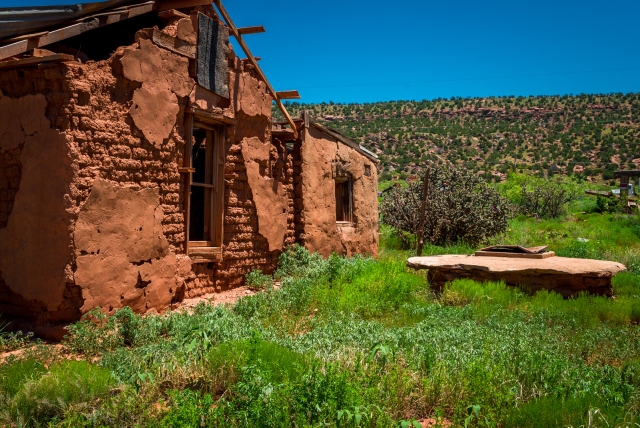
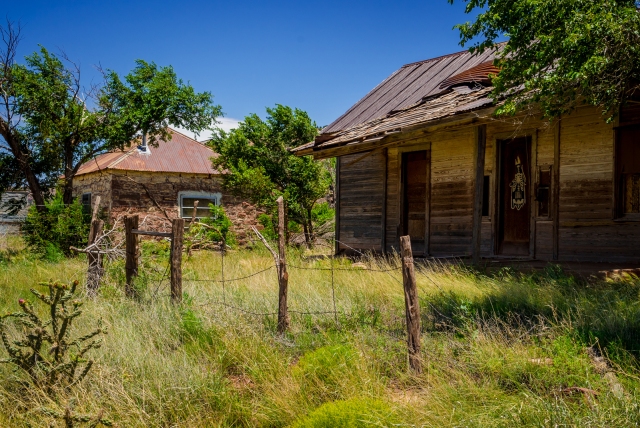
I was carried into Cuervo on the wings of pure luck – having been lost in my search for fuel, and something to drink. I became turned around attempting to navigate roads, suddenly finding myself directly roadside to this fascinating place. Noticing what I had just found, I quickly stopped, exited my car and began to examine the numerous abandoned structures surrounding me. A bright afternoon sun beat down onto the hot red dirt – the heat was intense as sun rays began to burn my neck. I still had yet to visit a gas station, and I was thirsty; holy fuck, was I thirsty. Here’s where common sense would kick in for most, telling them to find the nearest gas station or body of water immediately. Most sensible people would decide against traversing a dry desert town in 103-degree weather, with a mouth drier than the desert itself. Most people would not want to wander through that type of heat with threat of dehydration at hand; unfortunately I’m incredibly stubborn when I see something that I feel needs to be photographed. So what do I tell myself in these situations?
“Do the thing.”
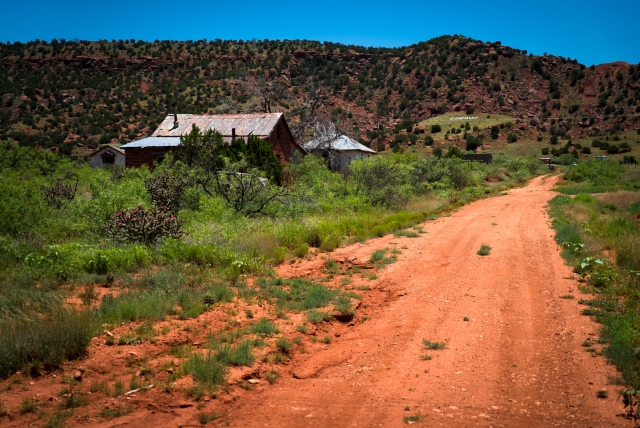
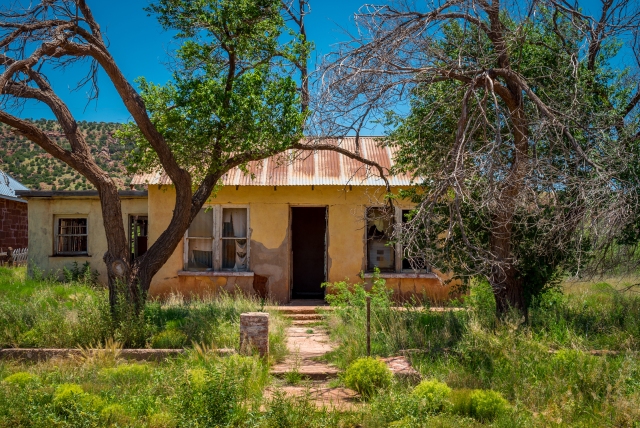
Sweat continuously fell from my face as I walked alongside cacti and crumbling adobe homes, kicking up dirt and stones with each step. I could swear I heard at least a few drops sizzle as they hit the hot ground – though it’s possible that could have just been my mind fizzling out. It was like tiny people were working a sweatshop inside my head, powering a bullet train by hand.
As homes and other structures continue to slowly deteriorate, collapsing into the dirt, I’m left wondering – ‘what is the story behind Cuervo?’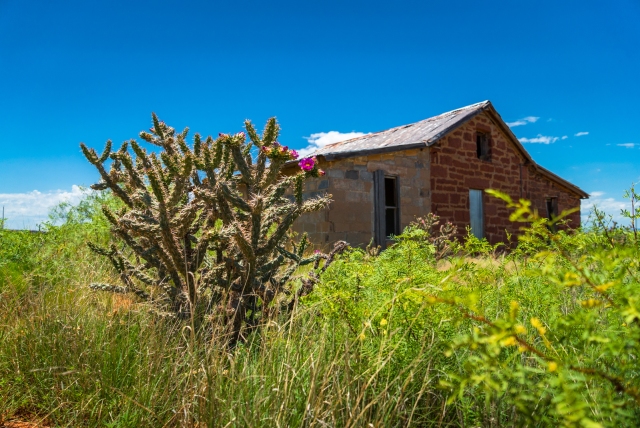
Cuervo is an unincorporated community in Guadalupe County, New Mexico. The Spanish word “Cuervo,” which translates from Spanish to English as “crow,” gives this town an even darker image given its current crumbling situation.
If we peek back in time -as far as the 1500s – we discover that this space, before being occupied by a town, was originally used as a water stop for travelers, as well as merchants carrying either slaves or sometimes goods. Juan de Córdoba of Seville became the first merchant we can identify to send an African slave to the New World in 1502. Juan de Córdoba is now dead. Merchants would continue to travel here from the south, passing through a nearby town now called Santa Rosa – established in 1865. It was not until many years later that inhabitation began for Cuervo. This means that long before the town even came to be, it had already seen so much life; it had so many stories to tell.
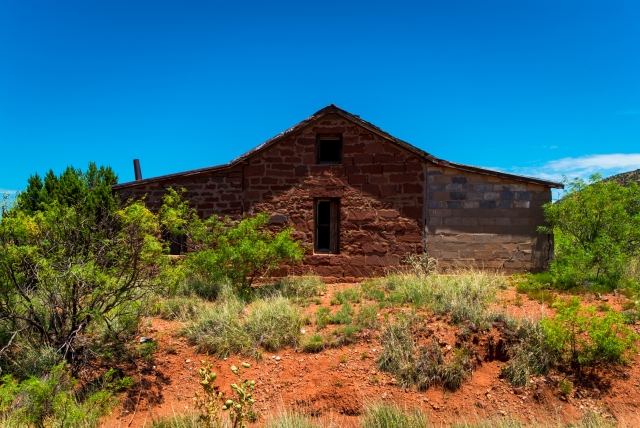
Cuervo, New Mexico was a simple railroad town, beginning its life in 1901 – this was when the CRI&P railroad passed through Guadalupe County. This railroad contained the Chicago, Rock Island, and Pacific Railroads. Only nine years later, the town was opened to cattle ranching in 1910.
At one point, Cuervo actually held two of almost every type of building – schools, churches, and clinics. Even hotels stood coupled as the construction of Route 66 swept through, carrying many a weary traveler through the desert plains. Many towns came to life strongly through Route 66 itself – being one of the original highways within the U.S. Highway System. Route 66 – also known as the Main Street of America, or the Mother Road – was and is still known to be one of the most famous highways for family’s road tripping across the country. Today, only the adventurous groups, and those interested in its history can be found making that journey. With the construction of I-40, a large chunk of Cuervo was ripped apart as they tore directly through the center of town, rushing citizens out, leaving buildings and vehicles abandoned for decades. This halted any chance the small town might have had at continuing a prosperous life in the way its people probably would have hoped. Both adobe and wooden residences remain, now littered with nothing but lost memories.

As noted earlier, Cuervo was never hugely populated; peaking at 300, with the 1946 census telling that the town held a mere 128 people. While the remaining population consists mainly of acacia, sage, and staghorn cholla cactus, a few people do remain within the town of Cuervo. It’s not certain why, but it’s almost like they’re living out the “apocalypse,” as they refuse to leave their homes behind. Up until September 10, 2011 the town had maintained a post office, but pieces continue to fall away. Each archaic adobe homestead continues to crumble beneath the desert sun. As I crept slowly, quietly down the road, it seemed like the end of time sat right in front of me. No gas, no food, no lodging…but plenty of vacancies.
Two Guns Arizona – Population 0

Two Guns, Arizona might just be the most fitting “Wild West” town I have ever visited. April of 2018 was my first time ever visiting Arizona, and this town was no doubt one of the most notable stops I made while there.
After days along Route 66 battling 20+ mph winds, they were finally starting to let up for us by the time we arrived in town. With a bit of wind still at our backs, we wandered the roads of Tow Guns, crossing a large, old stone and concrete bridge. This bridge connected the gap from one side of the canyon to the other, and lead us to the center of the village. The road through town is known as the National Trail Highway, and was the preferred route across Diablo Canyon by the 1920s as population continued to grow.

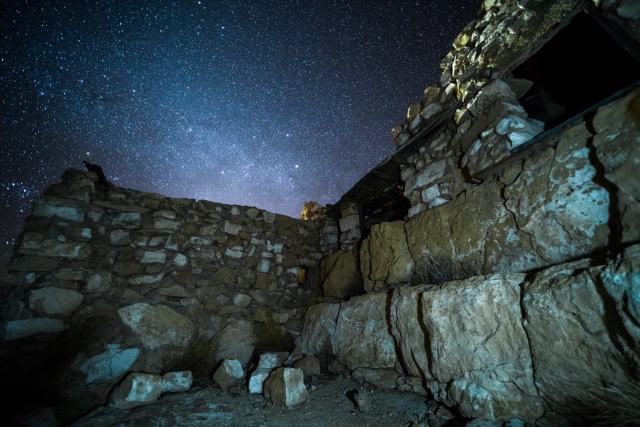

Long before the 20s though, Two Guns holds a rich, and wild history. Native artifacts dated between 1050 and 1600 AD have even been found in the town.
Initially, Two Guns operated as a trading post at the beginning of the 19th century, and was run by homesteaders Mr. and Mrs. Daniel B. Oldfield. More settlers began to populate the area through the mid-19th century, as the town offered an ideal crossover to Canyon Diablo.
In 1878, Two Guns became the site of a mass murder of Apaches by their enemies – the Navajo. In an attempt to hide out, and avoid detection, the Apaches crawled into a cave at Two Guns. Unfortunately, the Navajos took notice, and lit sagebrush fires at the cave’s exit, shooting any Apaches that attempted to escape. 42 other Apaches that were not shot were asphyxiated by smoke from the fire. They were then stripped of their valuables. The murder site became known as the “death cave.”
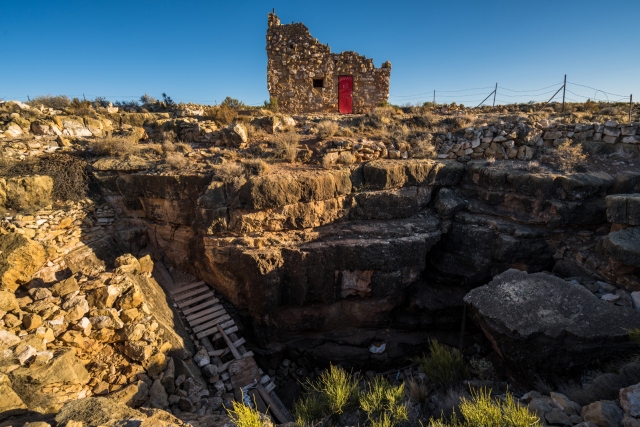
Billy the Kid even has some history with the town. During the winter of 1879-80, him and his outlaw gang turned ruins of a stone house into their hideout on the west rim of Canyon Diablo, directly across from Two Guns.
During the 1880s, the construction of the Santa Fe Railway progressed across northern Arizona. During its construction, a settlement was populated about 3 miles north of Two Guns. This settlement was named Canyon Diablo, after the nearby canyon. This settlement attracted drifters, gamblers and outlaws making their way through, and quickly became a wild, lawless town.

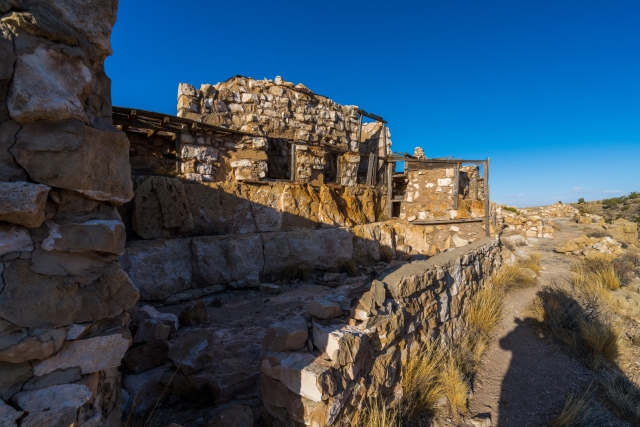
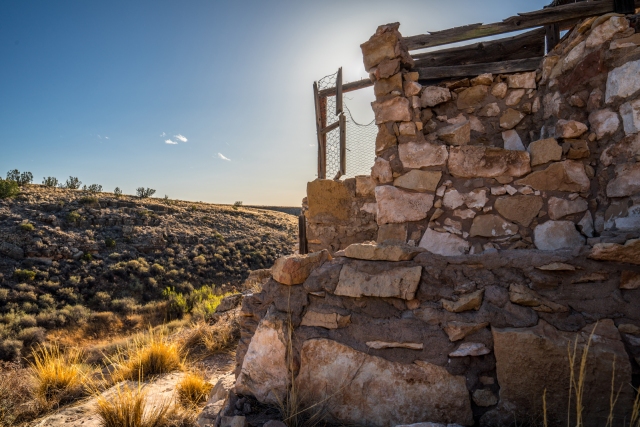
In 1889, four men robbed the train ay Canyon Diablo. The men were employees of the Hashknife Ranch. Successful in robbing the train, they then fled on horseback with $100,000 in currency, 2,500 new silver dollars, $40,000 in gold coins, silver watches, jewelry, and diamonds. Sheriff Buckey O’Neill and his posse caught up with the bandits, and were successful in apprehending them. Only $100 was recovered when the men were captured. Years later, after their release from prison, one thief informed a sheriff that the stolen goods, along with their rifles, were buried somewhere along the canyon’s rim near Two Guns. No other information was disclosed, and to this day, the area remains a popular destination for treasure hunters. Some argue that it was simply a case of a crooked sheriff, and the treasure was never buried at all. Others argue that the treasure has already been found, and the one who found it never spoke a word of it.
The first official settler at Two Guns was Ed Randolph. He built a store next to the death cave. In 1922, Earle and Louise Cundiff joined the picture, purchasing 320 acres of land from Ed. They then built a store, restaurant, and gasoline pumps on part of the 320 acres they had purchased. At that time, the 320 acres were acquired for only $1,000. In 1925, Harry E. Miller, a bit of an eccentric, leased property from the Cundiffs and began construction on some interesting things. He called himself “Chief Crazy Thunder” playing up the part for passing tourists. Along the canyon rim, Miller built a zoo with cages made of brick, mortar and chicken wire. As you’ll see in the accompanying photos, a lot of this remains to this day. Miller brought in mountain lions, cougars, gila monsters, coral snakes, birds and a lynx to display in his zoo. What a strange place for a zoo. Miller also opened a restaurant and Indian gift shop. He cleared the death cave of any remaining bones from Apaches, and sold their skulls as souvenirs for profit. I’d love to find one of the buyers of those!

The name “Two Guns” comes from Miller, who named his establishment “Fort Two Guns” as an homage to silent move actor William S. “Two Guns” Hart. Miller had really built the place up into quite the tourist destination, offering visitors a tour, which began at a Hopi house Miller had built. Rolls of colored piki bread were made and sold to the visitors. They were then led down a paved path along the canyon’s edge to a soft drink stand at the bottom. Visitors were then given a tour of the death cave, which had been decorated with fake ruins of cliff dwellers. Signs were placed all along the highway to promote “Fort Two Guns.”
1926 was the year when the highway would officially become Route 66, and the same year Miller would shoot Earle Cundiff over a disagreement. Cundiff was unarmed when the two got into a heavy argument about the details of their lease. Miller shot and killed Cundiff.
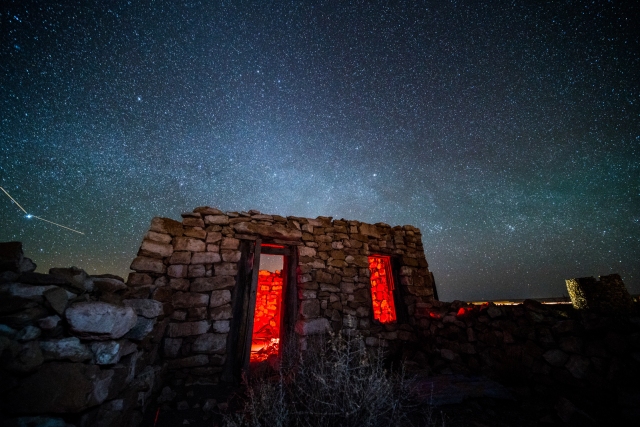
Miller’s store caught fire in 1929, burning the inside. Years of further development took place however, when Louise Cundiff built her own tourist store. Miller then left the state only one year later. In 1934, Cundiff had remarried and opened the Two Guns Texaco service station. By the 1960s, a motel, western tavern, reptile exhibit, Shell service station, KOA campground, and new zoo were added to attract tourists now that more families were road tripping Route 66.
The service station burned in 1971, and Two Guns began to decline. By the 1980s, it was a ghost town.

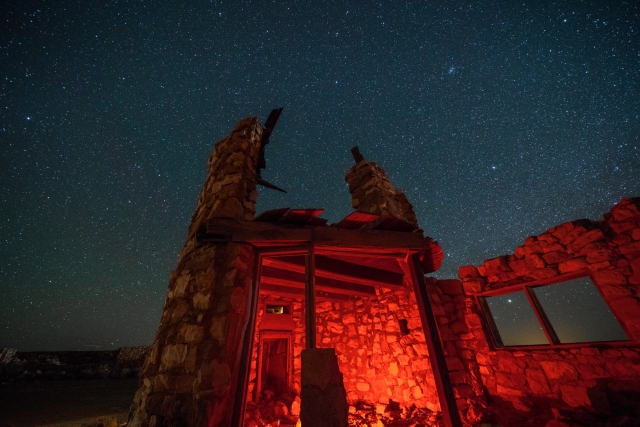
For years now, the town has remained empty and quiet. We walked along the backside of the structures at the canyon’s edge, looking out over a glowing landscape. The sun was warm, and lit the structures beautifully, bringing out the detail and texture of each stone. It was still quite apparent where had held mountain lions, unless they just wanted to mess with people and put something else in there. I’m guessing someone wouldn’t do that though.
Chloride Arizona – Population ?

During the 1840s, prospectors had found numerous mineral resources in the area, including silver, lead, gold, zinc, and turquois. Chloride was founded some years later, right around 1863, with widespread mining starting closer to the 1870s after a treaty was signed with the Hualapai Indians.

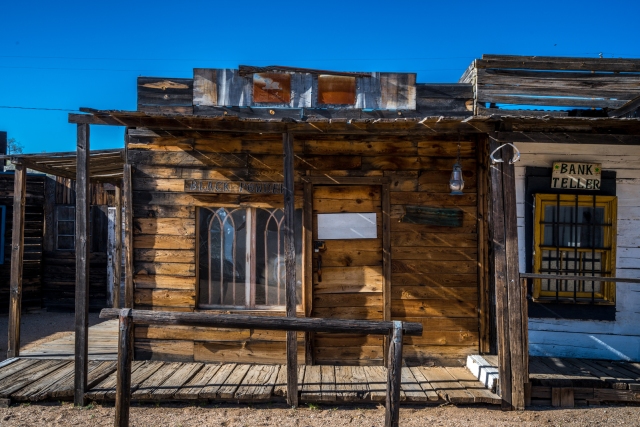
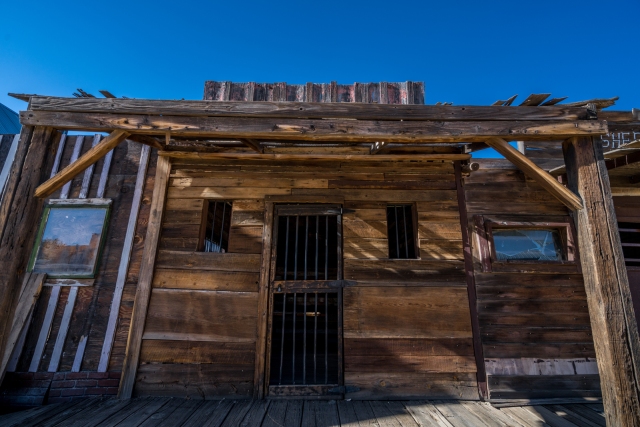

The Arizona and Utah railway was constructed from Kingman, and opened August 16, 1899. The final silver spike was driven by Miss May Krider. At one point, the town’s population had passed 5,000, with the town even becoming the county seat. By 1917 however, the population had fallen to 2,000, and by 1944 Chloride was practically a ghost town.

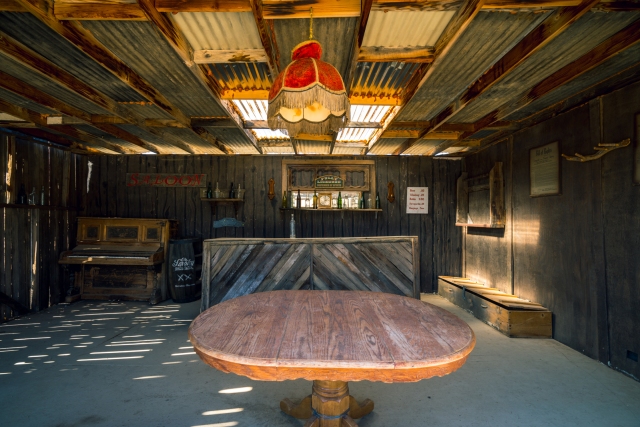
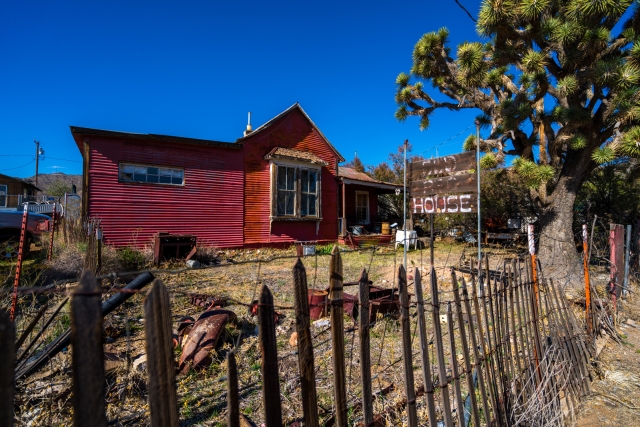
American author Louis L’Amour had visited the town between 1927 and 1929. During his visit, the town had caught fire. He had assisted the town’s citizens in putting out the fire, but it was a failed attempt, and most of the town had burned to the ground. There has now been a sort of “model” town put in place to replace most of what was taken out by the fire. Of course these are smaller, more “touristy” versions, but cool nonetheless! The house is original from information that I had gathered.

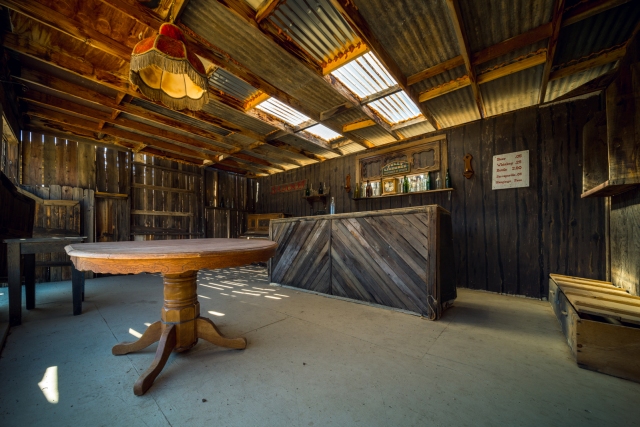
Very often, I’m asked what gear I use for my photography, videography, etc. Questions ranging from what type of camera/cameras I use, what lenses I use, backpacks, memory cards, even what type of laptop I recommend, or what type of introductory camera I recommend…all that stuff, and more!
Well, of course I love to recommend camera gear or adventure gear that I trust and love, so at the end of each post I create here on my blog, I like to give a bit of a run-down on gear I use almost all the time!
So here it is! My entire (or most of it) list of photography/editing/adventure gear that I use.
My Camera (Sony a7riii) – https://amzn.to/2AFtzQv
Alternative Camera – https://amzn.to/2VHjR9h
Theta 360 Camera – https://amzn.to/2CaRwzm
Sandisk Memory Cards – https://amzn.to/2SN5sX6
Sony 16-35 4.0 – https://amzn.to/2HgLFhN
Zeiss 55 1.8 – https://amzn.to/2SK4Dys
Zeiss 85 1.8 Batis – https://amzn.to/2SNRQLm
Laowa 12mm 2.8 Zero-D – https://amzn.to/2AESLXD
My Favorite Backpack – https://amzn.to/2RKTi44
Tripod 1 – https://amzn.to/2SKxxON
Tripod 2 – https://amzn.to/2M2gUM6
MSI Laptop (great for editing, & much more) – https://amzn.to/2shGfZn
My e-books – https://amzn.to/2Bumcwo
Hardcover books and prints available at – www.oddworldstudio.com
Yes, those links above are all affiliate links to Amazon, so yes I do get a very small percentage if you make a purchase through one of them. This helps me keep this blog up and running!






Your photography and writing are mind-blowing — magazine-worthy, even! Although all of the stories are fascinating in their own right, I especially loved the idea that “Shaniko calls the people she needs to survive.” Wonderful, wonderful post.
Thank you so much! I’m so glad you enjoy it all!
Beautiful photography…yet so desolate as well. It’s the emotion and beauty of the desolation and a sense of time past that is so captivating. Really enjoyed this.
Thank you very much! I’m glad you enjoyed it!
What do you do when you stumble onto an abandoned town all by yourself? Do you still walk around taking these once in a lifetime photos or do you turn around immediately? There is an eerie feeling seeing these photos without people in them.
I actually really enjoy being by myself in places like this. It’s relaxing.
I would imagine you get a sense of time and looking at a world long past. To me it would be very poignant, but somehow comforting in the grand scheme of everything being connected..past present and future.
Old abandoned homes and barns and industrial sites have the same appeal and emotions to me.
Amazing! I am NOT a fan of the games, but I am a fan of the historical value of your research. One day you might just be the “go to” person for American history. I hope you will write a hard copy book so my grandchildren can hold it and learn.
Thank you Beth! I actually do have a series of books, with my largest one yet just nearing completion. Those are available on my website http://www.oddworldstudio.com
Thanks for the link. I will bookmark it to search again. I really am serious about this history business.
What a wonderful series of pictures and stories of wild and abandoned places! I read them in my cottage in the Swedish winter at the Baltic, there is a bit of a storm coming up, and I start Wish, one day, I could see them in reality.
But maybe they are not real. They seem somewhat surreal, and maybe that is exactly what these places should be: outerworldly. You found them; that’s enough. We others can look at the images and read about the places. Thank you, explorer of the past!